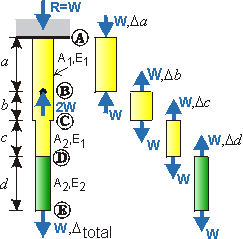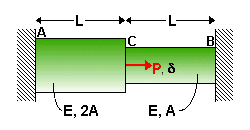Given: A stepped-bar (areas A1, A2) made of two materials (moduli E1, E2), acted on by forces 2W (upward at Pt. B) and W (downward at Pt. E).
Req'd: Determine the elongation of the bar Dtotal.
Sol'n:
Step 1. Equilibrium. Solve for internal forces between points where P(x), A(x) or E(x) change.
PAB = –W; PBC = PCD = PDE = W

Bar broken up into lengths with
constant force, area and modulus.
Step 2. Elongation/Force Relationship. To solve for the elongation, break the bar into lengths (segments) over which all the values (force, area and modulus) are constant.
The top such segment, AB, has length a, area A1, modulus E1, and internal force PAB = –W (compression). The change in length of AB is:
![]()
Since AB is in compression, it shortens: Da<0. Therefore, Point B moves up. Taking each of the other lengths with constant force, area and modulus:
![]()
Here, segments BC, CD and DE are all in tension, so each get longer.
Step 3. Compatibility. The total elongation or deflection Dtotal is:
![]()
The displacement of any point (upward or downward) depends on the extension (compression) of the bar segments above it.


